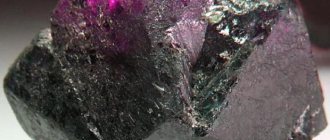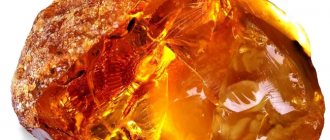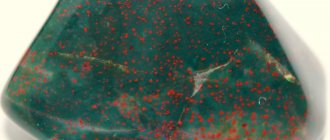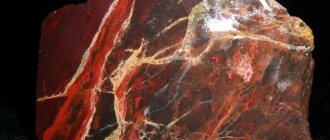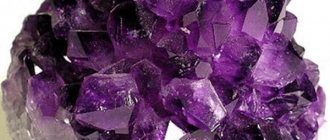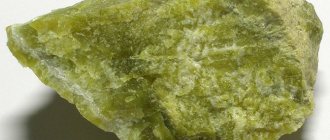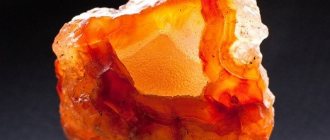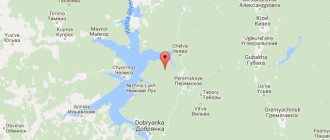Skarn Stone
Skarn is a generalized name for rocks of contact-metasomatic origin, which are dominated by silicates of iron, calcium, magnesium and manganese. The name is of Swedish origin and translates as “garbage”, “dirt”.
The stone is also called tactite, gornfels and seaside malachite. In Primorye, skarn occupies a place of honor in local folklore; paintings from it, due to its unique texture, carry a patriotic meaning (the cut of the stone reveals landscapes of Russian nature).
Depending on the composition of skarns and their origin, the color can vary in green, gray-green, white, brown and brown-pink shades. The texture of the stone is heterogeneous and can combine stripes and spots painted in different colors. Skarns are opaque, have low density, and are easy to cut and polish. The rock occurs in the form of veins, columnar crystals, lenses, layers and formations of irregular shape.
Varieties of mineral
Based on their chemical and mineralogical properties, skarns are divided into two types:
- Magnesian. Contain minerals rich in magnesium - spinel, dolomite, diopside or forsterite. Less common in the rock are orthite and sphene. In deposits with high iron content, forsterite is replaced by olivine. Deposits are formed at great depths or during the intrusion of magma into dolomites.
- Calcareous. They contain minerals of a granular or crystalline structure with a predominance of calcium - pyroxenes and calcium garnets adjacent to hematites and magnetites. Minor minerals in limestone deposits of skarns can be rhodonites, chalcopyrites, galenas and sphalerites. They are formed at surface or middle depths in the interaction of limestones with rocks of the aluminosilicate group.
Some general information and description
Skarn is formed during volcanic eruptions; it is essentially silicate magma that reacted with natural compounds and was cooled by air. Some of the minerals contained in its composition were ejected from the depths, and some were on the surface. Melting, they changed somewhat and formed a new rock, which is no longer called a mineral.
There are many types of skarns, but they are all divided into two types - calcareous and magnesian. Calcareous ones arise from the combination of limestones with silicate rocks, magnesian ones - from silicates and dolomites. Thus, what they have in common is the silicate component.
Calcareous skarns contain calcium minerals - calcium garnet, pyroxene, hematite, epidote. Some calcareous skarns contain galena, sphalerite, molybdenite, chalcopyrite, rhodonite and boron minerals. And they have a granular, crystalline or blast structure, a massive and heterogeneous texture, and look like spotty formations. In the rock they are found in the form of lenses, deposits, and irregularly shaped bodies.
Magnesian skarns contain magnesium minerals - spinel, dolomite, diopside, forsterite, apatite. Radioactive orthitis and sphene are also found. Magnesian skarns also form lenses and deposits, but can also be found in veins together with dolomitic marbles, granitoids, and dolomites.
Both calcareous and magnesian skarns consist of two main minerals, the rest are present in small quantities as impurities.
The density of both types of skarns is in the range of 2.5-3.4 grams per centimeter cubed. Hardness on the Mohs scale from 4 to 7 points. Magnesian skarns are harder, calcareous skarns are softer.
All skarns have a layered structure, with wavy lines that, when cut, form original and intricate patterns - this is their main value.
Samples mined at different deposits have a variety of colors; for example, in Primorye there is a lot of green skarn, which is called Primorsky malachite, although geologists and mineralogists call the rock datolite skarn.
Mineral deposits
Raw skarn
Almost always, skarns in the rock are formed in the vicinity of valuable minerals, so the feasibility of developing deposits is determined based on the quality, quantity and usefulness of the minerals.
Skarn deposits are of global importance. The most significant of them is the Dalnegorskoye field, located in the Primorsky Territory of Russia. It contains skarn deposits rich in zinc and lead ores, as well as inclusions of sphalerites and galenas. Also in Russia, rich stone deposits are formed in the eastern regions of Siberia, Karelia, the Urals and the Caucasus.
In Europe, skarns are mined in Norway, Sweden, Romania, Czech Republic, Bulgaria, and France. Deposits of the mineral embedded in rock containing gold are being developed in Mexico, Brazil and Korea. Stone mining in deposits with copper and tungsten is carried out in Kazakhstan, Turkey, Indonesia, Australia, Bolivia, Afghanistan, Argentina and the states of North America.
Limestone skarns
Mineral composition, structure and texture
The main minerals of calcareous skarns are pyroxene and garnet, although vesuvian or wollastonite skarns are occasionally found. Pyroxene usually has a diopside-hedenbergite composition, and garnet has a gorsular-andradite composition. Common types of calcareous skarns are vesuvianite, rhodonite, wollastonite, magnetite, scheelite, molybdenite, galena, chalcopyrite, and sphalerite.
Conditions of education and stay
They form deposits, lenses, bodies of irregular shape, zones in direct contact of granitoids with carbonate rocks (limestones).
Magical properties of skarn
The magical properties of skarn are more versatile. He is a generator of positive energy, capable of accumulating positive human qualities and sharing them with the owner.
The stone does not tolerate haste, so long-term close contact is required for its effect to manifest itself.
To maximize the magical properties of esotericists, they recommend wearing a ring with a skarn. Depending on which finger it is worn on, the stone exhibits its properties:
- on the little finger - skarn develops the gift of persuasion and eloquence, the ability to smooth out conflict situations through negotiations;
- on the ring finger - the stone will become a talisman of love relationships and family ties;
- on the middle finger - the mineral will give its owner inner peace and harmony in relationships with others;
- on the index finger – the stone enhances ambition and thirst for power, so it is not recommended to wear it often on this finger;
- on the thumb - the gem will help its owner achieve cherished goals with minimal energy and material costs.
Scarn makes a person softer, kinder, brings harmony into his life, teaches mercy and compassion. It creates a favorable atmosphere for contact with other people, teaches spiritual values and caring for the environment.
Metaphysics of skarn
Our distant ancestors, the Slavs, considered any stones to be the bones of the Earth, its foundation and support. It is not surprising that most of them were attributed magical and healing properties, because they are part of the Earth, from which people themselves were once made.
And the skarn, which in cross-section reveals pictures of Russian nature, was even more so considered congenial. This part of Mother Earth, which so accurately replicates her landscapes, was used to make amulets and amulets.
Especially many legends associated with skarn can be heard in the Primorsky Territory, where there are deposits of stone. So, according to the legend about the creation of the region, it is said that God at first forgot about this area, but then decided to create it from materials left over from the creation of other areas. As a result, now in the region you can find elements from both the north and the south. It also contains skarn, which was given to the region instead of malachite.
People believed that if a skarn product was not broken, stolen or lost in the first month after purchase, it means that the stone agreed to live next to its owner and help him, sharing positive energy.
Scarn is credited with the ability to accumulate positivity and transfer it to the owner. Thanks to this proximity, a person becomes softer, kinder, more reasonable and calmer. Communicating with other people, he learns to be merciful, sociable, compassionate, and begins to pay attention to other people's problems.
Lithotherapists pay attention to the fact that jewelry with skarn, worn on different fingers, has different effects on the owner. They should not be worn on the index finger, which symbolizes control, power and kingship. This is nothing like a modest and peaceful pebble that does not seek to dominate and rule. It is best to wear it on the ring finger, in which case it will provide the owner with peace and stability in relationships with the outside world and people.
Scarn on the little finger will help you find a way out of a difficult situation, avoid conflicts, and gently convince your interlocutor that you are right. The stone on the thumb will help you achieve your goal with little energy expenditure.
A stone in which two different minerals easily coexist has healing properties. It harmonizes the surrounding space, relieves nervous tension, relaxes muscles, dilates blood vessels and thereby makes a person healthier. Scarn is an indispensable assistant in meditation and achieving complete relaxation.
In the Primorsky Territory, they believe that skarn is an effective remedy for migraines; for this purpose, it is applied to the temples and the frontal part of the head.
Application
A figurine of a bear made of skarn stone.
The unusual texture, combined with a large assortment of shades and flexibility in processing, make skarn in demand in crafts. The uses of skarn are varied. Souvenir balls, eggs, animal figures, candlesticks and vases are carved from stone. The patterns characteristic of the mineral in the form of mountain ranges or coniferous forests look impressive on wall panels and frescoes that are made from stone layers.
Scarn is not used in jewelry, but it makes beautiful jewelry. Bracelets, beads and pendants are cut from it. Cabochon-cut stones are set in silver or jewelry alloy and inserted into earrings and rings.
The stone is not used in industrial sectors, but in deposits in close proximity to it there are large deposits of ores rich in copper, molybdenum, zinc, tungsten, lead, iron, cobalt and gold.
How to wear jewelry?
Anyone can wear products with skarn, regardless of gender and age. Women are recommended to use light-colored stones, while men tend to use dark-colored gems.
Jewelry with small skarn inserts is more suitable for young girls and women under 40 years old. Older ladies should pay attention to massive stones.
Scarn goes well with casual and business attire. In the latter case, jewelry with it will give its owner courage, openness and impressiveness.
Price of products
Pendant with skarn
Jewelry, crafts made from skarn and collectible stones of small sizes have an affordable price:
- $2-5 – for pebbles ranging in size from 20 to 65 mm;
- $22-34 – for crafts in the form of animal figurines up to 100 mm high;
- $20 – for skarn beads 62 cm long;
- $26-38 – for a souvenir ball with a diameter of up to 55 mm;
- $37-42 - for a ring in a silver frame with a stone weighing from 6 to 12 grams;
- $75-82 - for earrings made of silver with a stone weighing from 9 to 18 grams.
Single large specimens of skarn and products made from it can be very expensive. For example, a bowl measuring 330x420x150 mm, made from solid skarn, the deposit of which is the Primorsky Territory of Russia, costs $1,350.
Magnesian skarns
Magnesian skarns, as a special type of metasomatic rocks, were identified in 1953 by D.S. Korzhinsky.
Magnesian skarns are spinel-forsterite-clinopyroxene rocks with a large number of minor and accessory minerals. Some magnesian skarns are formed at the magmatic stage, while others are post-magmatic formations. Igneous-stage skarns are formed by the interaction of magnesian carbonate rocks with solutions that separate from the magma before its crystallization is complete or circulate in the host rocks at this time. The formation of skarns before the complete solidification of the magmatic melt is proven by the absence of endoskarns, the appearance of apophysis of unchanged igneous rocks crossing metasomatic rocks, as well as the presence of xenoliths of magnesian skarns in the endocontact parts of intrusive massifs.
Source breeds. Magnesian skarns are formed from dolomites and magnesites. The MgO content in carbonate rocks sufficient for the formation of magnesian skarns is 12-13 wt.. At the post-magmatic stage, magnesian skarns can also form on granites, granite-gneisses and migmatites, which are in contact with Mg-bearing carbonate rocks.
Conditions of occurrence of metasomatic rocks. Magnesian skarns are found in two geological settings: 1) in deep granite-gneiss complexes of ancient shields; 2) near the contacts of granitoid intrusions, less often syenites, gabbroids and even ultrabasic rocks. Skarn formation is most complete in connection with granitoid magmatism. Magnesian skarns are formed at all depth levels, with the exception of near-surface ones. In abyssal conditions, they form sheet and lens-shaped bodies, the thickness of which reaches several hundred meters and a length of up to 1.0 – 1.5 km. Layered bodies are confined to dolomite horizons and lie in agreement with the host rocks. In the exocontact zones of intrusions, magnesium skarns occur in the form of steeply dipping pillars, tubular bodies, veins, and also form frontal deposits of bizarre shape.
The thickness of the bodies varies from tens of centimeters and a few meters to 100 m. Individual columnar bodies have been traced to a depth of up to 800 m.
Mineral composition. The main minerals of igneous-stage skarns are forsterite, spinel, clinopipoxenes (diopside or fassaite), calcite and, less commonly, dolomite. In deep conditions, enstatite and hypersthene are added to these minerals. At shallow depths, monticellite, merwinite and periclase appear, while forsterite and calcite disappear.
Minor and accessory minerals in skarns are represented by magnetite, apatite, and in near-skarn rocks - sphene.
The most recent new formations in magnesian skarns include phlogopite, amphiboles, borates, sulfides and other superimposed minerals.
Varieties of magnesian skarns are distinguished by their mineral composition. The most widely developed are forsterite, spinel-forsterite, pyroxene and spinel-pyroxene skarns. Near unchanged carbonate rocks, calciphyres are formed, consisting of carbonates, forsterite, the amount of which usually does not exceed 30 vol., and spinel (less than 10 vol.). Near-skarn rocks contain plagioclase, the amount of which reaches 40-60 vol.
Forsterite, containing less than 5 mol. Fe2SiO4, is a typical calciphyre mineral; in forsterite skarns, iron content increases to 10–15 mol.
Dolomite occurs only in calciphyres; in pyroxene-containing rocks it is unstable and is replaced by calcite.
Spinel in calciphyres is represented by green, less often pink and yellow varieties, containing from 5 to 20 mol. hercynite component. In pyroxene skarns, the iron content of the mineral increases to 20-40 mol.. Spinel is unevenly distributed.
Clinopyroxenes belong to fassaite or diopside, between which gradual transitions are established. The iron content of both minerals is close and amounts to 2-7. In near-skarn rocks, the iron content of clinopyroxene increases to 30-40. The alumina content in diopside is 1-2 wt., and in fassaite it increases to 4-9, sometimes up to 15-16 wt.
Orthopyroxene from skarns is represented by enstatite containing less than 15 ferrosilite molecules. In near-scarn rocks, hypersthene is more typical, containing up to 45 mol. Fe2SiO3. In near-skarn rocks, basic plagioclase (An50-100) sometimes appears, less often andesine (An40-49) in association with K-Na feldspar.
Magnesian skarns of the post-magmatic stage differ from skarns of the magmatic stage in the smaller amount of spinel, the greater role of calcite, and the increased iron content of non-ferrous minerals. Chemical composition. Compared to the original carbonate rocks, the content of Al and Si increases in magnesian skarns of the magmatic stage, and the accumulation of Si is naturally associated with an increase in the intensity of metasomatism. Mg undergoes local redistribution, accumulating in forsterite skarns.
In postmagmatic exoskarns, accumulation of Si and Fe occurs, partial removal of Mg and Ca with insignificant migration of alumina, and in endoskarns, on the contrary, accumulation of Mg and Ca occurs, with a decrease in the Si content.
Appearance. Forsterite and pyroxene skarns are green or dark greenish-gray; Calciphyres are a white rock. The structure of magnesian skarns varies from fine to coarse-grained. Fine-crystalline rocks have a hornfels appearance. The texture of skarns is massive, spotted, while calciphyres and forsterite skarns are banded, due to the chain arrangement of dark-colored minerals and spinel in the carbonate mass.
Microstructures are granoblastic and heteroblastic. In all varieties of skarns, the metasomatic nature of mineral formation is manifested, expressed in the development of pseudomorphs along primary minerals or their aggregates.
Stages and zoning of metasomatic rocks. Magnesium scans are characterized by stable and clearly defined zoning. According to V.A. Zharikova 1986 and L.I. Shabynin 1973, the following metasomatic column is typical for magnesian skarns of great depths:
0. Dolomite 1. Calciphyre: Fo + Shp + Ka + Do 2. Spinel-forsterite skarn: Fo + Shp + Ka 3. Spinel-pyroxene skarn: Pi + Shp + Ka 4. Pyroxene-plagioclase rock: Pi + Pl 0. Aluminosilicate rock (granite, gneiss) Columns of a slightly different type are typical for moderate depths:
0. Dolomite 1. Calciphyre: Fo + Shp + Ka + Per 2. Forsterite skarn: Fo + Shp + Ka 3. Pyroxene skarn: Pi + Shp + Ka 0. Granite
0. Dolomite marble 1. Calcite-periclase marble: Ka + Per 2. Spinel-forsterite calciphyre: Shp + Fo + Ka + Per 3. Spinel-forsterite skarn or calciphyre: Shp + Fo + Ka 4. Spinel-forsterite-pyroxene skarn : Shp + Fo + Pi 5. Spinel-pyroxene skarn: Shp + Pi 6. Pyroxene-plagioclase near-skarn rock: Pi + Pl 0. Granitoid, gneiss
In shallow conditions, spinel-forsterite and calcite-periclase zones are absent. Instead of forsterite, monticellite appears in associations with spinel, and periclase appears instead of calcite. As the temperature rises, spinel and monticellite are replaced by gehlenite.
The zoning of magmatic stage magnesian skarns is often obscured by later processes associated with the seepage of post-magmatic solutions. In the magnesian skarns transformed by these solutions, minerals from the humite group, phlogopite, pargasite, blue-green hornblende and scapolite appear. At the same time, a phlogopite-clinohumite association develops in spinel-forsterite skarns; Spinel-fassaite skarns are replaced by phlogopite and pargasite-phlogopite rocks, and near-skarn pyroxene-plagioclase rocks are transformed into amphibole-scapolite metasomatites with phlogopite.
Subsequently, a complex of low-temperature minerals (tremolite, actinolite, amesite, serpentine, talc and brucite) appears in the altered skarns, representing a specific propylitic association, which intensively replaces minerals of the post-magmatic stage and relict minerals of magnesian skarns.
Even later superimposed mineral parageneses in skarns are associated with the action of acidic solutions, leading to the formation of mica and beresite.
The formation of skarn deposits is associated with the processes of calcium and magnesium metasomatism occurring at the contacts of acidic and moderately acidic granitoids (granites, granodiorites, syenites) with their host carbonate, less often silicate rocks. The optimal depth range is 500-2000 m. The temperatures of their formation, according to most researchers, vary widely - from 900 to 250 °C. The process develops in several stages, during which the aggregative state of the solutions changes - and from pneumatolytic they become typical hydrothermal.
Deposits of magnesian skarns are formed by replacing dolomites and dolomitized limestones. Typomorphic minerals of magnesian skarns are diopside, forsterite, spinel, phlogopite, serpentine, magnetite, ludwigite, dolomite, and calcite. Ore bodies are represented by lenses, sheet-like and complex deposits. Their zonal structure is characteristic. Ludwigite-magnetite, phlogopite and chrytzotile-asbestos deposits are of greatest industrial importance.
Stone care
To preserve the skarn in its original form, compliance with the minimum rules of care is required. It is not afraid of sunlight, moisture and high temperatures, but is poorly resistant to mechanical stress. Due to its average softness and low density, the stone cannot be subjected to falls or impacts. You should especially protect the gem from squeezing, as it can break into several pieces.
It is recommended to use a separate box for storing skarn. If this is not possible, then storing this stone along with other minerals is allowed only in a separate fabric bag.
If the stone becomes dirty, just wash it in soapy water or wipe it with a damp cloth.
What is a skarn?
The formation of the stone occurred in the active phase of life of ancient volcanoes with dominance in the structure:
- iron silicates;
- calcium;
- magnesium;
- manganese
Melted under high temperatures, the minerals formed an unusual rock. The structure of skarns is mainly layered with various wavy lines that form beautiful, original and intricate patterns on the cut. Such magical stones are found in gray-green, white, brown-pink and green shades. The difference in mineralogical and chemical properties led to the division into two categories, presented in the table:
| View | Content | Formation | Density, g/cm3 |
| Magnesian skarns | Spinel | At significant depths or when magma intrudes into dolomites | 2,5—3,4 |
| Forsterite | |||
| Dolomite | |||
| Diopside | |||
| Calcite | |||
| Limestone skarns | Rhodonite | On the surface or shallow | 2,5—3,4 |
| Pyroxene | |||
| Calcium Garnet | |||
| Hematite |

